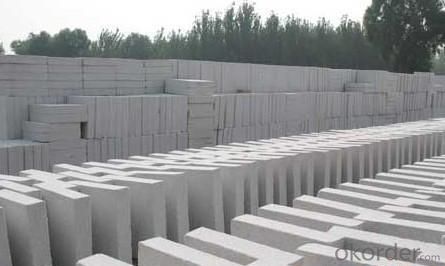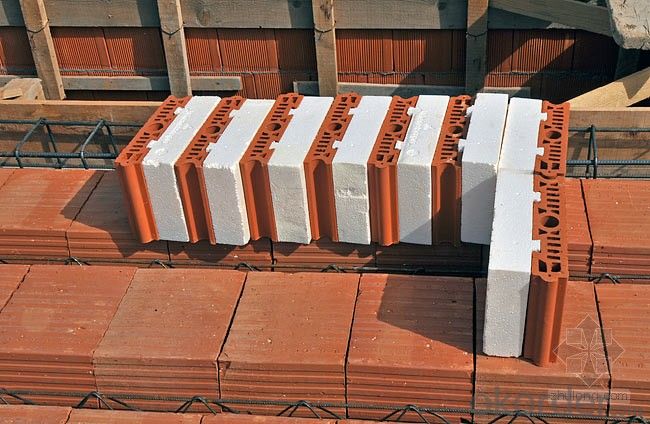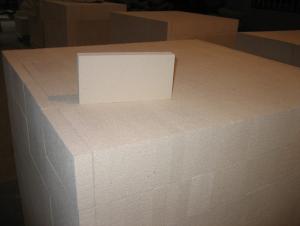Refractory Mullite Insulating Refractory Brick JM 38
- Loading Port:
- Shanghai
- Payment Terms:
- TT OR LC
- Min Order Qty:
- 20 m.t.
- Supply Capability:
- 20 m.t./month
OKorder Service Pledge
OKorder Financial Service
You Might Also Like
Okorder series heat insulation brick
Okorder series thermal insulation brick is an effective, energy saving, low carbon, environmental protection advanced, according to the ASTM standard manufacturing products. Okorder series products have all kinds of materials in the field of metallurgy, industrial furnaces, aluminum, the best Li Ning petrochemical and insulation, electric power and glass ceramics. They can be used as part of an insulation or not to melt. Products have been widely used in the following furnace, achieved satisfactory results.
Application of heat preservation brick
Metallurgical Industry: blast furnace, hot blast furnace, heating furnace, etc..
Petrochemical Industry: ethylene cracking furnace, hydrogen furnace, the main furnace, heating furnace, etc..
Ceramic industry: roller kiln, kiln, etc..
Glass industry: glass furnace regenerator, etc.
Carbon industry: carbon furnace, etc..
Aluminum electrolysis industry: aluminum reduction cell, etc.
Other industries: tunnel kiln, shuttle kiln, etc..
Advantages of heat insulation brick
Low thermal conductivity: many air holes will bring good thermal insulation effect, energy saving.
High crushing strength: high crushing strength, volume stability.
Low heat storage: small heat storage, absorb more heat, energy-saving effect is obvious.
Chundu: High-speed Rail, low content of alkali metal impurities.
Accuracy: the size of the brick machining precision, cutting and grinding the special shape, speed up the brick.
Insulating brick


- Q:Can insulating fire bricks be used for fireplace construction?
- Indeed, insulating fire bricks are suitable for constructing fireplaces. These bricks are specifically engineered to endure extreme temperatures while offering superb insulation, rendering them perfect for lining fireplaces. They aid in retaining heat, improving fireplace efficiency, and preventing heat dissipation. Furthermore, insulating fire bricks possess a lightweight quality, facilitating easier handling and installation. Ultimately, opting for insulating fire bricks in fireplace construction is a pragmatic decision that can enhance fireplace performance and energy efficiency.
- Q:How do insulating fire bricks prevent heat transfer?
- Insulating fire bricks prevent heat transfer through a combination of their composition and structure. These bricks are made from special refractory materials that have high thermal resistance, such as silica, alumina, or clay. These materials have low thermal conductivity, meaning they do not easily conduct heat. Additionally, insulating fire bricks are often manufactured with small air pockets or cells within their structure. These air pockets act as barriers to heat transfer, as air is a poor conductor of heat. When heat is applied to one side of the brick, the low thermal conductivity of the refractory materials and the presence of air pockets work together to minimize the amount of heat that is conducted through the brick. This effectively prevents heat transfer from one side of the brick to the other, providing insulation and reducing energy loss.
- Q:What is the weight of an average insulating fire brick?
- The size and composition of an average insulating fire brick can cause its weight to differ. On average, these bricks weigh around 2.5 to 5 pounds (1.13 to 2.27 kilograms). They are specifically engineered to be lightweight, enabling effortless handling and installation in different thermal insulation applications.
- Q:How do insulating fire bricks help reduce heat loss through convection?
- Insulating fire bricks have been specifically designed to minimize heat loss through convection, achieving this by establishing a barrier that obstructs the movement of air and heat transfer. Made from lightweight refractory materials with low thermal conductivity, these bricks are inadequate conductors of heat and do not easily permit heat to pass through them. Upon implementation in construction projects, these bricks establish an insulating layer that effectively diminishes heat transfer by convection. Convection, characterized as the process of heat transfer through the motion of air or fluid particles, is interrupted by the insulating fire bricks which function as a barrier, hindering the unrestricted flow of air and impeding convective currents. The bricks are engineered with small interconnected air pockets or pores that capture and trap air within them. These air pockets act as insulators, curtailing the convection-driven heat transfer. The trapped air forms a stagnant layer, restricting air movement and preventing heat from escaping or infiltrating the area. By reducing heat loss through convection, insulating fire bricks facilitate the maintenance of a stable and comfortable temperature within a structure. They are commonly employed in scenarios where heat insulation is imperative, such as industrial furnaces, kilns, and fireplaces. These bricks not only enhance energy efficiency by diminishing heat loss, but also contribute to fire safety by impeding the propagation of heat to adjacent areas.
- Q:How long do insulating fire bricks last?
- Insulating fire bricks have a relatively long lifespan, typically lasting for several decades under normal usage conditions.
- Q:Are there any special requirements for the use of raw materials in thermal insulation brick production equipment? What about the raw materials?
- Specific funding, different production, different raw materials configuration will be different. According to the design requirements, refining production process, for production process, production management level, complete monitoring, pulping system on the lower computer, based on control level; lower machine by the programmable controller (PLC) is mainly composed of a crushing system. The host computer takes the standard industrial control computer (IPC) as the main man-machine interface (HMI) and beating system, and if possible, it is recommended to investigate on site
- Q:Are insulating fire bricks resistant to oil and gas?
- Insulating fire bricks typically offer resistance against oil and gas. These bricks are crafted from high temperature materials like alumina and silica, which grant exceptional thermal insulation qualities and can endure elevated temperatures. They are commonly employed in industries where exposure to heat occurs, such as furnaces, kilns, and fireplaces. Nevertheless, it is crucial to acknowledge that the resistance to oil and gas can vary depending on the precise composition and manufacturing process of the insulating fire bricks. Certain bricks may exhibit higher resistance to oil and gas compared to others. To guarantee the utmost resistance to oil and gas, it is recommended to utilize insulating fire bricks that are specifically engineered for such applications. These bricks are often known as oil and gas resistant fire bricks and are formulated with supplementary additives or coatings that enhance their resistance to these substances. In conclusion, although insulating fire bricks generally offer resistance to oil and gas, it is advisable to employ bricks that are specifically tailored for such applications to ensure optimal performance and longevity.
- Q:Can insulating fire bricks be used in residential fireplaces?
- Yes, insulating fire bricks can be used in residential fireplaces. These bricks are designed to withstand high temperatures, making them an ideal choice for lining the interior of a fireplace. They help to retain heat and improve the overall efficiency of the fireplace. Additionally, insulating fire bricks are lightweight and easy to install, making them a practical option for residential use.
- Q:Can insulating fire bricks be used in ladle covers?
- Insulating fire bricks can indeed be used in ladle covers. These bricks are specially designed to have low thermal conductivity, which means they can effectively insulate and retain heat. Ladle covers are used in foundries and other high-temperature industries to keep molten metal or other materials hot and prevent heat loss. By using insulating fire bricks in ladle covers, the heat is better retained, resulting in improved energy efficiency and reduced fuel consumption. Additionally, these bricks have high refractory properties, allowing them to withstand the extreme temperatures and thermal shock that ladles are subjected to. Overall, insulating fire bricks are an excellent choice for ladle covers, as they help to maintain temperature stability and conserve heat.
- Q:Are insulating fire bricks suitable for insulation in power boilers?
- Insulating fire bricks can be suitable for insulation in power boilers depending on the specific requirements and conditions of the boiler. Insulating fire bricks are known for their high temperature resistance and low thermal conductivity, which makes them effective in reducing heat loss and improving energy efficiency in various applications. However, when considering their use in power boilers, several factors need to be taken into account. Firstly, the operating temperature and pressure of the boiler should be considered to ensure that the insulating fire bricks can withstand these conditions without any degradation or failure. Power boilers typically operate at high temperatures and pressures, so it is important to choose insulating fire bricks that have a high temperature rating and can withstand the required pressure. Additionally, the composition and structure of the insulating fire bricks should be considered. Some power boilers may contain corrosive or abrasive substances, which can potentially damage the insulating fire bricks over time. Therefore, it is important to select insulating fire bricks that are resistant to corrosion and abrasion, or to consider additional protective measures such as coatings or linings. Furthermore, the thermal conductivity of the insulating fire bricks should be evaluated. While insulating fire bricks have low thermal conductivity compared to other refractory materials, it is important to ensure that they provide sufficient insulation for the specific requirements of the power boiler. This may involve calculating heat transfer rates and determining the appropriate thickness and density of the insulating fire bricks to achieve the desired insulation performance. Ultimately, the suitability of insulating fire bricks for insulation in power boilers depends on careful consideration of factors such as temperature, pressure, composition, structure, and thermal conductivity. Engaging with experts and conducting proper evaluations and calculations will help determine if insulating fire bricks are a suitable choice for insulation in a particular power boiler application.
1. Manufacturer Overview |
|
|---|---|
| Location | |
| Year Established | |
| Annual Output Value | |
| Main Markets | |
| Company Certifications | |
2. Manufacturer Certificates |
|
|---|---|
| a) Certification Name | |
| Range | |
| Reference | |
| Validity Period | |
3. Manufacturer Capability |
|
|---|---|
| a)Trade Capacity | |
| Nearest Port | |
| Export Percentage | |
| No.of Employees in Trade Department | |
| Language Spoken: | |
| b)Factory Information | |
| Factory Size: | |
| No. of Production Lines | |
| Contract Manufacturing | |
| Product Price Range | |
Send your message to us
Refractory Mullite Insulating Refractory Brick JM 38
- Loading Port:
- Shanghai
- Payment Terms:
- TT OR LC
- Min Order Qty:
- 20 m.t.
- Supply Capability:
- 20 m.t./month
OKorder Service Pledge
OKorder Financial Service
Similar products
New products
Hot products
Related keywords




























